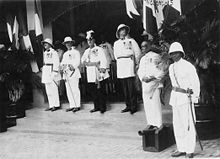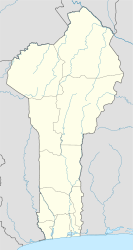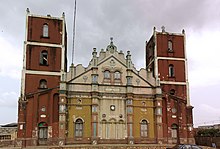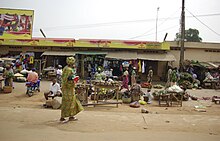Porto-Novo
| Municipalité de Porto-Novo Porto-Novo |
||
|---|---|---|
|
|
||
| Coordinates | 6 ° 29 ′ 0 ″ N , 2 ° 37 ′ 0 ″ E | |
| Basic data | ||
| Country | Benin | |
| Ouémé | ||
| ISO 3166-2 | BJ-OU | |
| height | 22 m | |
| surface | 52 km² | |
| Residents | 264,320 (2013) | |
| density | 5,083.1 Ew. / km² | |
| politics | ||
| mayor | Moukaram Océni | |
|
Porto-Novo in the Ouémé department
|
||
Porto-Novo ( Portuguese for "New Port" ) is the capital of Benin .
With almost 270,000 inhabitants, it is the second largest city in the country after Cotonou . Porto-Novo is the seat of the National Assembly of Benin , the President and some ministries . Most ministries, however, are based in Cotonou, which is also the country's economic center. Porto-Novo is also the capital of the Ouémé department . In the Goun language the city has the name Hogbonou, in the Yoruba language the name Adjatchê .
geography
Location and urban structure
Porto-Novo is a port city on the Porto-Novo Lagoon , an extension of the Badagry Creek , which is an arm of the Gulf of Guinea that runs parallel to the coast . The state border with Nigeria is about five kilometers east of Porto-Novo. The neighboring municipalities of the city are Akpro-Missérété and Avrankou in the north, Adjarra in the north and east, Sèmè-kpodji in the south and Aguégué in the west.
In terms of its layout, the 52 km 2 city can be divided into four large parts: the historic old town, the commercial district with the Grand Marché ("large market") in the southwest, the administrative district with the government buildings in the west and the new residential area in the east . In administrative terms, Porto-Novo consists of five arrondissements , which in turn are made up of quartiers (city districts).
climate
Porto-Novo has a tropical climate. The relative humidity averages 75%, the annual precipitation 1200 mm . The air temperature varies between 21.9 ° C and 32.8 ° C. There are two dry seasons, from mid-November to mid-March and from mid-July to mid-September, and two rainy seasons, from mid-March to mid-July and from mid-September to mid-November. From December to January there are large temperature fluctuations during the day due to the harmattan .
history

Porto-Novo was founded either as early as the 16th century or around 1730 after the city of Allada was conquered by the Kingdom of Dahomey . Since its inception, Porto-Novo has been under the influence of the Kingdom of Oyo . According to tradition, one of the first known rulers of Porto-Novos, which as a state was initially still called Ajase Ipo , was King Tê Agbalin (1688–1729). The slave trade with the Portuguese , the namesake of the city and kingdom, brought an economic boom. When the kingdom of Dahomey occupied the port city of Ouidah , Porto-Novo became the preferred port of call for slave traders.
In the 19th century, France replaced Portugal and saved the city from the constant military threat posed by the Kingdom of Dahomey. The " Protection Treaty " with France was signed in 1863 after British anti-slavery ships attacked the port in 1861 . An attack by Dahomey on Porto-Novo gave the French the opportunity to submit to Dahomey. In 1883 Porto-Novo was incorporated into the French colony of Dahomey. When King Toffa of Porto-Novo (1874–1908) died, the Kingdom of Porto-Novo formally ceased to exist. France founded a canton of Porto-Novo and installed King Toffa's descendants as canton chiefs. Porto-Novo was the starting point for the French conquests of the region and it was for this reason that it became the capital of the colony of Dahomey, later the Republic of Benin, in 1900.
The 2012 African Athletics Championships took place in Porto-Novo.
population
Porto-Novo has 267,191 inhabitants (as of 2012).
Population development:
- 1979 (census): 133,168 inhabitants
- 1992 (census): 179,138 inhabitants
- 2002 (census): 223,552 inhabitants
- 2013 (census): 264,320 inhabitants
In 2002, 90.46% of the population were younger than 50 years. Ethnically, about two-thirds of the population are Goun and Fon and about a quarter are Yoruba . Porto-Novo is located in the center of the Yoruba settlement area in Benin. The ethnic minorities living in the city include Adja , Mina and Toffin , among others . According to the 2002 census, 45.7% of the population belong to Christian communities, 25.1% are Muslims and 29.2% followers of traditional religions such as Voodoo . Among the Christians are Evangelicals , Catholics , Protestants and followers of Christianisme Céleste .
politics
The Mayor of Porto-Novo has been Moukaram Océni since 2008 . The town hall is located in the Agbokou district. In the exercise of his functions, the mayor is supported by his own cabinet and a general secretariat, which comprises three technical directorates. The arrondissements are headed by chefs d'Arrondissements (district heads), who report to the heads of the districts, the chefs des quartiers .
Culture and sights
The city center is characterized by historic buildings, colonial mansions and stone-paved streets. The architecture and culture partly reveals Afro-Brazilian influences, as some descendants of African slaves from Brazil settled in the city.
The National Museum of Porto-Novo was established in King Toffa's palace in the 1980s with foreign funds. It is also known as the Honmé Museum . With the Musée ethnographique Alexandre-Sénou-Adandé de Porto-Novo, there is an ethnographic museum founded in 1962 that specializes in the Yoruba money , which has been recognized by UNESCO as intangible world heritage since 2008 .
Outstanding examples of the Afro-Brazilian architecture of the city are the museum building of the Musée Da Silva des Arts et de la Culture, built in 1890, and the building of the Grande Mosquée ("great mosque "). The Cathédrale Notre Dame de l'Immaculée Conception , the seat of the Roman Catholic diocese of Porto-Novo , was built in the 1880s. The Église du Christianisme Céleste , a Christian church founded in 1947, is also based in the city.
The National Library of Benin is also located in Porto-Novo. In the west of the city there is a large botanical garden .
In Charles-de-Gaulle Stadium various sports such as are basketball , handball , volleyball and bocce practiced. Football clubs from Porto-Novo are the AS Dragons FC de l'Ouémé , the Mogas 90 FC and the USS Kraké .
Economy and Infrastructure
Economic life in Porto-Novo is largely based on the informal economy . The city is the center of an agricultural region whose main products are palm oil and cotton and which Kapok exports. Yoruba in particular are active in trade, while many Goun and Fon work in agriculture and transport. Porto-Novo was connected to Cotonou, about thirty kilometers away, by a railway line. The city is the seat of the Ecole Régionale Supérieure de la Magistrature (ERSURMA), a university of the Organization pour l'harmonisation en Afrique du droit des affaires (OHADA), and the Ecole du Patrimoine Africain , an international university with the aim of preserving the African cultural heritage. Porto-Novo and Cotonou are connected to international air traffic through Cadjehoun Airport .
sons and daughters of the town
- Sadikou Ayo Alao (* 1943), lawyer
- Sourou-Migan Apithy (1913–1989), President of Benin
- Azonhon Faton (1957–2008), director, playwright and actor
- Romuald Hazoumé (* 1962), artist
- Roger Houngbédji (* 1963), Catholic clergyman, Archbishop of Cotonou
- Louis Ignacio-Pinto (1903–1984), lawyer, diplomat and politician
- Moussa Latoundji (* 1978), football player
- Samuel BJ Oschoffa (1909–1985), church founder and head of the Celestial Church of Christ
- Didier Sossa (* 1993), football player
- Paulin Soumanou Vieyra (1925–1987), pioneer of African cinema
Web links
- Official website
- Monograph de la ville de Porto-Novo . Afrique Conseil, March 2006 (PDF; 497 kB, French).
Footnotes
- ^ A b c d e f Mathurin C. Houngnikpo, Samuel Decalo: Historical Dictionary of Benin . 4th edition. Scarecrow Press, Plymouth 2013, ISBN 978-0-8108-7171-7 , pp. 297-298 .
- ↑ a b Monograph de la ville de Porto-Novo. (PDF; 497 kB) Afrique Conseil, March 2006, p. 8 , accessed on August 10, 2013 (French).
- ↑ a b c d Erika Kraus, Felicie Reid: Benin . Other Places Publishing, Durham 2010, ISBN 978-0-9822619-1-0 , pp. 112-114 .
- ↑ a b Monograph de la ville de Porto-Novo. (PDF; 497 kB) Afrique Conseil, March 2006, p. 11 , accessed on August 10, 2013 (French).
- ↑ Mathurin C. Houngnikpo, Samuel Decalo: Historical Dictionary of Benin . 4th edition. Scarecrow Press, Plymouth 2013, ISBN 978-0-8108-7171-7 , pp. 170 .
- ↑ a b Mathurin C. Houngnikpo, Samuel Decalo: Historical Dictionary of Benin . 4th edition. Scarecrow Press, Plymouth 2013, ISBN 978-0-8108-7171-7 , pp. 201 .
- ^ Porto Novo African Championships (BEN). In: All-Athlectics.com. Retrieved August 10, 2013 .
- ↑ Benin. In: citypopulation.de. Thomas Brinkhoff, May 20, 2011, accessed August 10, 2013 .
- ↑ Benin: Departments & Cities - Population Statistics in Maps and Tables. Retrieved May 8, 2018 .
- ↑ a b c Monograph de la ville de Porto-Novo. (PDF; 497 kB) Afrique Conseil, March 2006, pp. 17–18 , accessed on August 10, 2013 (French).
- ↑ Le Maire Moukaram Océni appelle les pêcheurs-fouilleurs à plus de solidarité et d'assistance volontaire. In: Fraternité. July 2, 2013, accessed August 10, 2013 (French).
- ↑ Erika Kraus, Felicie Reid: Benin . Other Places Publishing, Durham 2010, ISBN 978-0-9822619-1-0 , pp. 111 .
- ↑ Mathurin C. Houngnikpo, Samuel Decalo: Historical Dictionary of Benin . 4th edition. Scarecrow Press, Plymouth 2013, ISBN 978-0-8108-7171-7 , pp. 299 .
- ↑ Oral heritage of Gelede. UNESCO, accessed on August 10, 2013 .
- ^ The Celestial Church of Christ Constitution. (No longer available online.) Celestial Church of Christ (Nigeria Diocese), archived from the original August 24, 2013 ; accessed on August 10, 2013 . Info: The archive link was inserted automatically and has not yet been checked. Please check the original and archive link according to the instructions and then remove this notice.
- ↑ Mathurin C. Houngnikpo, Samuel Decalo: Historical Dictionary of Benin . 4th edition. Scarecrow Press, Plymouth 2013, ISBN 978-0-8108-7171-7 , pp. 61 .
- ^ Julio Bovi Diogo, Eric Boesenberg: Benin - List of Champions. RSSSF , May 13, 2013, accessed August 10, 2013 .
- ↑ stage in Benin. In: World Stadiums. Retrieved August 10, 2013 .
- ↑ Monograph de la ville de Porto-Novo. (PDF; 497 kB) Afrique Conseil, March 2006, p. 27 , accessed on August 10, 2013 (French).
- ^ The International Geographic Encyclopedia and Atlas . Macmillan, London 1979, ISBN 978-0-333-27498-9 , pp. 623 .
- ↑ ERSURMA. (No longer available online.) OHADA , archived from the original on August 15, 2013 ; Retrieved August 10, 2013 (French). Info: The archive link was inserted automatically and has not yet been checked. Please check the original and archive link according to the instructions and then remove this notice.
- ^ Vision, missions et valeurs. Ecole du Patrimoine Africain, November 13, 2013, accessed on July 21, 2016 (French).





